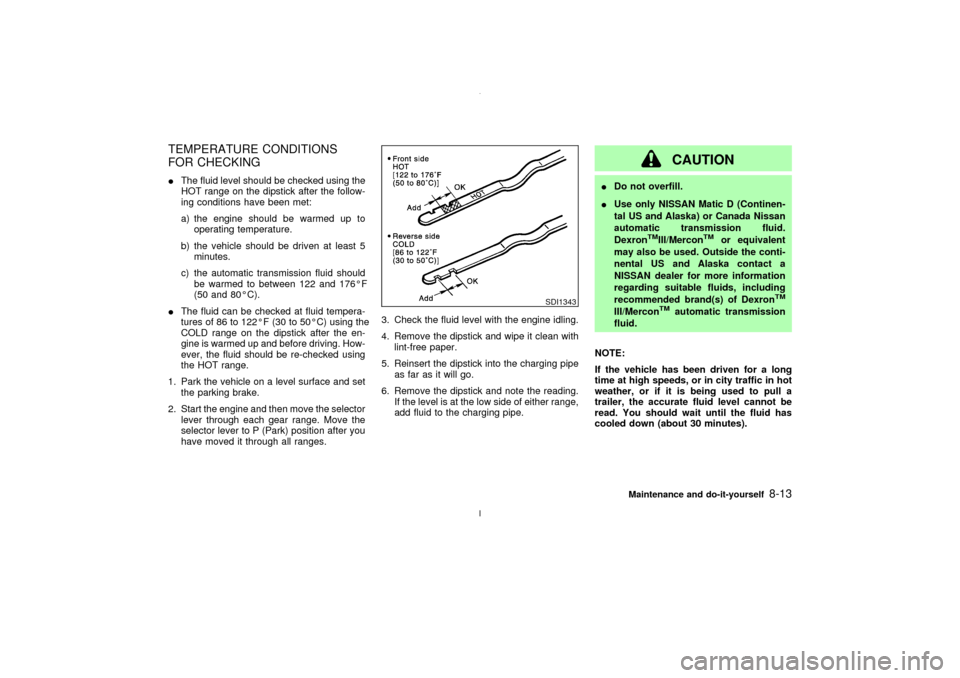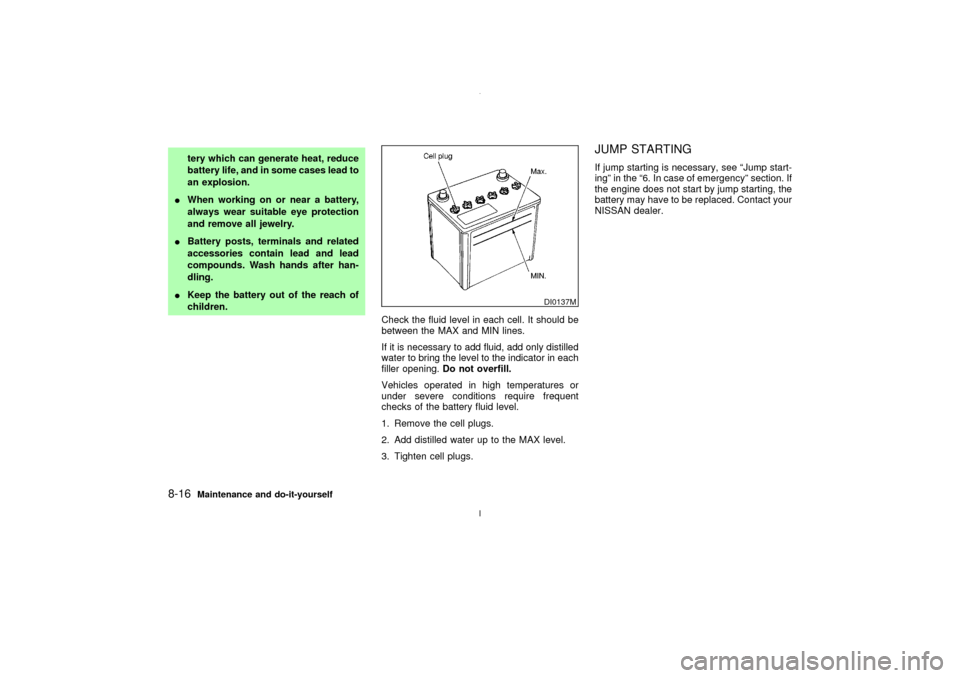Page 188 of 247

TEMPERATURE CONDITIONS
FOR CHECKINGIThe fluid level should be checked using the
HOT range on the dipstick after the follow-
ing conditions have been met:
a) the engine should be warmed up to
operating temperature.
b) the vehicle should be driven at least 5
minutes.
c) the automatic transmission fluid should
be warmed to between 122 and 176ÉF
(50 and 80ÉC).
IThe fluid can be checked at fluid tempera-
tures of 86 to 122ÉF (30 to 50ÉC) using the
COLD range on the dipstick after the en-
gine is warmed up and before driving. How-
ever, the fluid should be re-checked using
the HOT range.
1. Park the vehicle on a level surface and set
the parking brake.
2. Start the engine and then move the selector
lever through each gear range. Move the
selector lever to P (Park) position after you
have moved it through all ranges.3. Check the fluid level with the engine idling.
4. Remove the dipstick and wipe it clean with
lint-free paper.
5. Reinsert the dipstick into the charging pipe
as far as it will go.
6. Remove the dipstick and note the reading.
If the level is at the low side of either range,
add fluid to the charging pipe.
CAUTION
IDo not overfill.
IUse only NISSAN Matic D (Continen-
tal US and Alaska) or Canada Nissan
automatic transmission fluid.
Dexron
TMIII/Mercon
TM
or equivalent
may also be used. Outside the conti-
nental US and Alaska contact a
NISSAN dealer for more information
regarding suitable fluids, including
recommended brand(s) of Dexron
TM
III/Mercon
TM
automatic transmission
fluid.
NOTE:
If the vehicle has been driven for a long
time at high speeds, or in city traffic in hot
weather, or if it is being used to pull a
trailer, the accurate fluid level cannot be
read. You should wait until the fluid has
cooled down (about 30 minutes).
SDI1343
Maintenance and do-it-yourself
8-13
Z
02.7.12/A33-D/V5.0
X
Page 189 of 247
Check the fluid level in the reservoir tank.
The fluid level should be checked using the
HOT range at fluid temperatures of 122 to
176ÉF (50 to 80ÉC) or using the COLD range at
fluid temperatures of 32 to 86ÉF (0 to 30ÉC).
CAUTION
IDo not overfill.
IUse Genuine Nissan PSFII or equiva-
lent.Check the fluid level in the reservoir. If the fluid
is below the MIN line or the brake warning light
comes on, addDOT 3fluid up to the MAX line.
If fluid must be added frequently, the system
should be thoroughly checked by your
NISSAN dealer.
WARNING
Use only new fluid. Old, inferior, or con-
taminated fluid may damage the brake
and clutch systems. The use of im-
proper fluids can damage the brake sys-tem and affect the vehicle's stopping
ability.
CAUTION
Do not spill the fluid on painted sur-
faces. This will damage the paint. If fluid
is spilled, wash with water.
SDI1076
SDI0119
POWER STEERING FLUID BRAKE AND CLUTCH FLUID8-14
Maintenance and do-it-yourself
Z
02.7.12/A33-D/V5.0
X
Page 190 of 247

Add fluid when the low washer fluid warning
light comes on. Add a washer solvent to the
water for better cleaning. In the winter season,
add a windshield washer anti-freeze. Follow
the manufacturer's instructions for the mixture
ratio.
WARNING
Anti-freeze is poisonous and should be
stored carefully in marked containers
out of the reach of children.
CAUTION
Do not substitute engine anti-freeze
coolant for window washer solution.
This may result in damage to the paint.IKeep the battery surface clean and dry. Any
corrosion should be washed off with a
solution of baking soda and water.
IMake certain the terminal connections are
clean and securely tightened.
IIf the vehicle is not to be used for 30 days or
longer, disconnect the (Ð) negative battery
terminal cable to prevent discharging it.
WARNING
IDo not expose the battery to flames
or electrical sparks. Hydrogen gas
generated by battery action is explo-
sive. Do not allow battery fluid to
contact your skin, eyes, fabrics, or
painted surfaces. After touching a
battery or battery cap, do not touch or
rub your eyes. Thoroughly wash your
hands. If the acid contacts your eyes,
skin or clothing, immediately flush
with water for at least 15 minutes and
seek medical attention.
IDo not operate the vehicle if the fluid
in the battery is low. Low battery fluid
can cause a higher load on the bat-
SDI0961A
WINDOW WASHER FLUID BATTERY
Maintenance and do-it-yourself
8-15
Z
02.7.12/A33-D/V5.0
X
Page 191 of 247

tery which can generate heat, reduce
battery life, and in some cases lead to
an explosion.
IWhen working on or near a battery,
always wear suitable eye protection
and remove all jewelry.
IBattery posts, terminals and related
accessories contain lead and lead
compounds. Wash hands after han-
dling.
IKeep the battery out of the reach of
children.
Check the fluid level in each cell. It should be
between the MAX and MIN lines.
If it is necessary to add fluid, add only distilled
water to bring the level to the indicator in each
filler opening.Do not overfill.
Vehicles operated in high temperatures or
under severe conditions require frequent
checks of the battery fluid level.
1. Remove the cell plugs.
2. Add distilled water up to the MAX level.
3. Tighten cell plugs.
JUMP STARTINGIf jump starting is necessary, see ªJump start-
ingº in the ª6. In case of emergencyº section. If
the engine does not start by jump starting, the
battery may have to be replaced. Contact your
NISSAN dealer.
DI0137M
8-16
Maintenance and do-it-yourself
Z
02.7.12/A33-D/V5.0
X
Page 192 of 247
WARNING
Be sure the ignition key is in the OFF or
LOCK position. The engine could rotate
unexpectedly.
1. Visually inspect each belt for signs of un-
usual wear, cuts, fraying, oil adhesion or
looseness. If the belt is in poor condition or
loose, have it replaced or adjusted by your
NISSAN dealer.2. Have the belts checked regularly for condi-
tion and tension.
WARNING
Be sure the engine and ignition switch
are off and that the parking brake is
engaged securely.
CAUTION
Be sure to use the correct socket to
remove the spark plugs. An incorrect
socket can damage the spark plugs.
SDI0141
DRIVE BELTS SPARK PLUGS
Maintenance and do-it-yourself
8-17
Z
02.7.12/A33-D/V5.0
X
Page 193 of 247

REPLACING SPARK PLUGS
Platinum-tipped spark plugsIt is not necessary to replace the platinum-
tipped spark plugs as frequently as the con-
ventional type spark plugs since they will last
much longer. Follow the maintenance sched-
ule but, do not reuse them by cleaning or
regapping.
If replacement is required, see your NISSAN
dealer for servicing.
Always replace with recommended
platinum-tipped spark plugs.The filter element should not be cleaned and
reused. Replace it according to the mainte-
nance intervals. See the separate Service and
Maintenance Guide. When replacing the filter,
wipe the inside of the air cleaner housing and
the cover with a damp cloth.
WARNING
IOperating the engine with the air
cleaner removed can cause you or
others to be burned. The air cleanernot only cleans the air, it stops flame
if the engine backfires. If it is not
there, and the engine backfires, you
could be burned. Do not drive with
the air cleaner removed and be care-
ful when working on the engine with
the air cleaner removed.
INever pour fuel into the throttle body
or attempt to start the engine with the
air cleaner removed. Doing so could
result in serious injury.
SDI0145
SDI0963
AIR CLEANER
8-18
Maintenance and do-it-yourself
Z
02.7.12/A33-D/V5.0
X
Page 194 of 247
CAUTION
IAfter wiper blade replacement, return
the wiper arm to its original position.
Otherwise it may be damaged when
the engine hood is opened.
IMake sure the wiper blade contacts
the glass, otherwise the arm may be
damaged from wind pressure.
IWorn windshield wiper blades can
damage the windshield and impair
driver vision.CLEANINGIf your windshield is not clear after using the
windshield washer or if a wiper blade chatters
when running, wax or other material may be on
the blade or windshield.
Clean the outside of the windshield with a
washer solution or a mild detergent. Your
windshield is clean if beads do not form when
rinsing with clear water.
Clean the blade by wiping it with a cloth
soaked in a washer solution or a mild deter-gent. Then rinse the blade with clear water. If
your windshield is still not clear after cleaning
the blades and using the wiper, replace the
blades.WINDSHIELD WIPER BLADES
Maintenance and do-it-yourself
8-19
Z
02.7.12/A33-D/V5.0
X
Page 195 of 247
REPLACINGReplace the wiper blades if they are worn.
1. Pull the wiper arm.
2. Push the lock pin, then remove the wiper
blade.
3. Insert the new wiper blade to the wiper arm
until a click sounds.
If you wax the surface of the hood, be
careful not to let wax get into the washer
nozzle. This may clog the nozzle that could
cause improper windshield washer opera-
tion. If wax gets into the nozzle, unclog it
with a needle or small pin.
DI1018M
SDI0146
8-20
Maintenance and do-it-yourself
Z
02.7.12/A33-D/V5.0
X